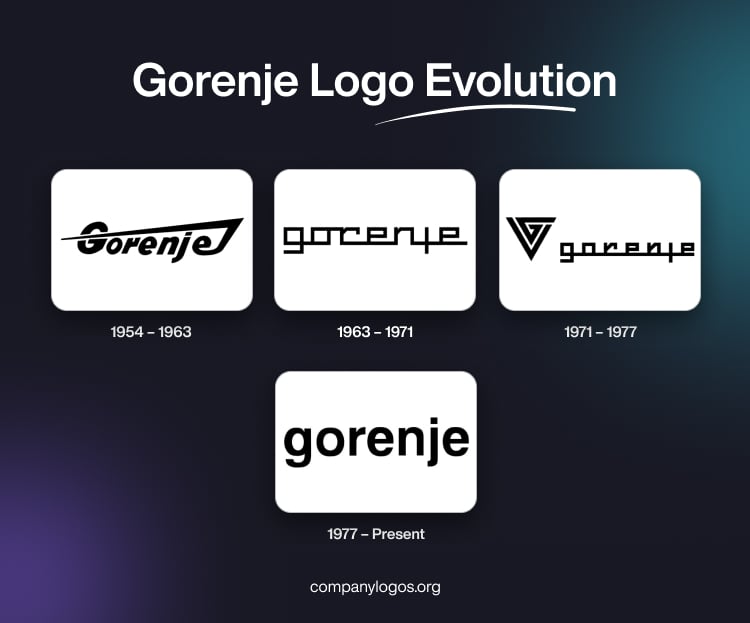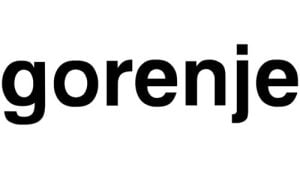
Gorenje is a Slovakia-based manufacturer of household appliances. Its varied product portfolio includes refrigerators, kitchen appliances, dishwashers, washing machines, and small appliances used for both domestic and commercial use. The company is also into manufacturing furniture and ceramics that are used in bathrooms and kitchens. With a foothold in more than 90 countries, the brand maintains a strong focus on the European market.
The Gorenje logo has evolved significantly since the company’s founding in 1950. The logo iterations show the growth of the company from a local manufacturer to an international brand. The logo has undergone four major changes, where each marks a new era for the company. Its current minimalist wordmark was introduced in 1977 and is still in use today. The article delves into the evolution of the Gorenje logo over the years, among other details about the company.
The Genesis of the Gorenje Logo (1954 – 1963)
The very first logo of Gorenje was introduced in 1954, a few years after its founding. This original logo, which was in use until 1963, represented the company’s initial phase as a small manufacturer producing agricultural machinery, just as it started to expand into household appliances. It showed the brand name in black placed at an angle with the last letter “e” extended to form a flame-inspired glyph.

(1963 – 1971)
The second logo was adopted in 1963, and it reflected a period of diversification and modernisation. By this time, Gorenje had begun producing solid-fuel cookers and washing machines, and the logo update matched its ambition to be seen as a more modern appliance manufacturer. The logo in black against a white background featured a digital touch where each glyph seemed to have flown into the next letter to create a dynamic effect. Depicting the letters to be in motion, the logo was less legible, especially when it came to the merging of the letters “r” and “e”.

(1971 – 1977)
From 1971, the company used its third logo by introducing a stylised upended triangular emblem to the already existing logotype. The wordmark written using a grotesque typeface was made smaller. Also, the glyph in the letter “g” was extended to the last letter “e”. The logo elements were depicted in black.

(1977 – Present)
The fourth and current logo was introduced in 1977, and it has continued to represent the company for nearly five decades. It is characterised by its simple, clean text mark “gorenje” in lowercase letters without serifs. There is no unnecessary graphic element either, unlike the previous logo.
This consistency in branding has helped Gorenje to remain recognisable over vast economic and technological changes. It also withstood other changes, such as multiple expansions and the acquisition of the company by Hisense in 2018.

The Elements of the Gorenje Logo
Font
The wordmark forming the Gorenje logo is written using a classic bold sans-serif typeface with smooth contours. The spacious characters of the wordmark improve readability and create a cohesive image.
Colour
The logo is in black monochrome, which reflects professionalism. Besides, it contrasts well with the white background for better readability.
The History of Gorenje
Gorenje was founded in 1950 in the small village of Gorenje, in Slovenia (then part of Yugoslavia). The company originally produced agricultural machinery and solid-fuel stoves. Its first factory was modest and had only a handful of employees. However, the brand soon established itself as an innovative and quality-driven manufacturer.
In 1958, Gorenje relocated its operations to the town of Velenje, Slovenia, which remains its headquarters today. During this period, the company shifted its focus toward producing home appliances, especially solid-fuel cookers, which became widely popular across Yugoslavia. This transition marked the beginning of Gorenje’s evolution into a household name.
By the 1970s, Gorenje had diversified into manufacturing a full range of household appliances, which included washing machines, refrigerators, and dishwashers. The company also began expanding internationally by exporting its products across Europe and beyond. Gorenje became known for combining functionality with design, which appealed to both domestic and international consumers.
After the breakup of Yugoslavia in the 1990s, Gorenje adapted to the new European market economy. It positioned itself as a modern, design-oriented appliance producer and started working with renowned designers such as Pininfarina, Ora-Ïto, and Karim Rashid. These collaborations brought stylish, contemporary aesthetics to its products, thereby enhancing its reputation globally.
The company also expanded its presence in Central and Eastern Europe while maintaining strong brand recognition in Western Europe. By the early 2000s, Gorenje had grown into one of the top appliance manufacturers in Europe. In the 2010s, Gorenje focused on strengthening its brand portfolio, innovation, and global outreach. It acquired and collaborated with several European companies and brands to expand its market reach. The company became increasingly recognised for its energy-efficient appliances and forward-thinking design.
A major turning point came in 2018 when the Chinese electronics giant Hisense acquired a majority stake in Gorenje. This move gave Gorenje access to Hisense’s global resources, technology, and distribution networks. This allowed it to expand further into Asia and other international markets.
Gorenje operates as part of the Hisense Group and continues to maintain its European identity, design excellence, and innovation in home appliances. It is particularly strong in Slovenia, Central Europe, and Scandinavia, with a growing global footprint.
Interesting Facts About Gorenje
- Gorenje started in 1950 in a tiny Slovenian village called Gorenje. The company name still honours its birthplace.
- Its first products were not kitchen appliances but agricultural machinery and solid-fuel stoves. It transitioned into manufacturing home appliances later.
- In 1958, the company moved to Velenje, Slovenia, where its headquarters and main production facilities are still located.
- Gorenje is one of the few Slovenian brands known worldwide. It competes with major European appliance makers like Bosch, Electrolux, and Whirlpool.
- The brand is famous for collaborating with world-renowned designers such as Pininfarina (Italian car design firm), Ora-Ïto, and Karim Rashid. These collaborations give its appliances a unique stylish edge.
- Gorenje has a popular retro-style collection of refrigerators and appliances, which became a trendsetter in kitchen design.
- The company is known for producing eco-friendly, energy-efficient appliances and aligns with Europe’s strict environmental standards.
- In its home country, Gorenje is considered a national symbol of Slovenian industrial success and innovation.
- In 2018, Gorenje was acquired by Hisense Group, a major Chinese electronics giant, which helped it expand into Asian and global markets.
- Gorenje products are sold in over 90 countries worldwide, thereby making it one of Slovenia’s most international brands.
- The company has a legacy spanning more than seven decades. It evolved from a small workshop into a globally recognised appliance manufacturer.
- Gorenje has won multiple design and innovation awards in Europe for its combination of aesthetics, technology, and sustainability.
Finally
The evolution of the Gorenje logo shows the strategic shifts made by the company. These include starting from its roots in postwar Yugoslavia to becoming a strong, pan-European brand. The longevity of the current logo reflects the company’s steady identity and its adaptability to changing markets and ownership structures.